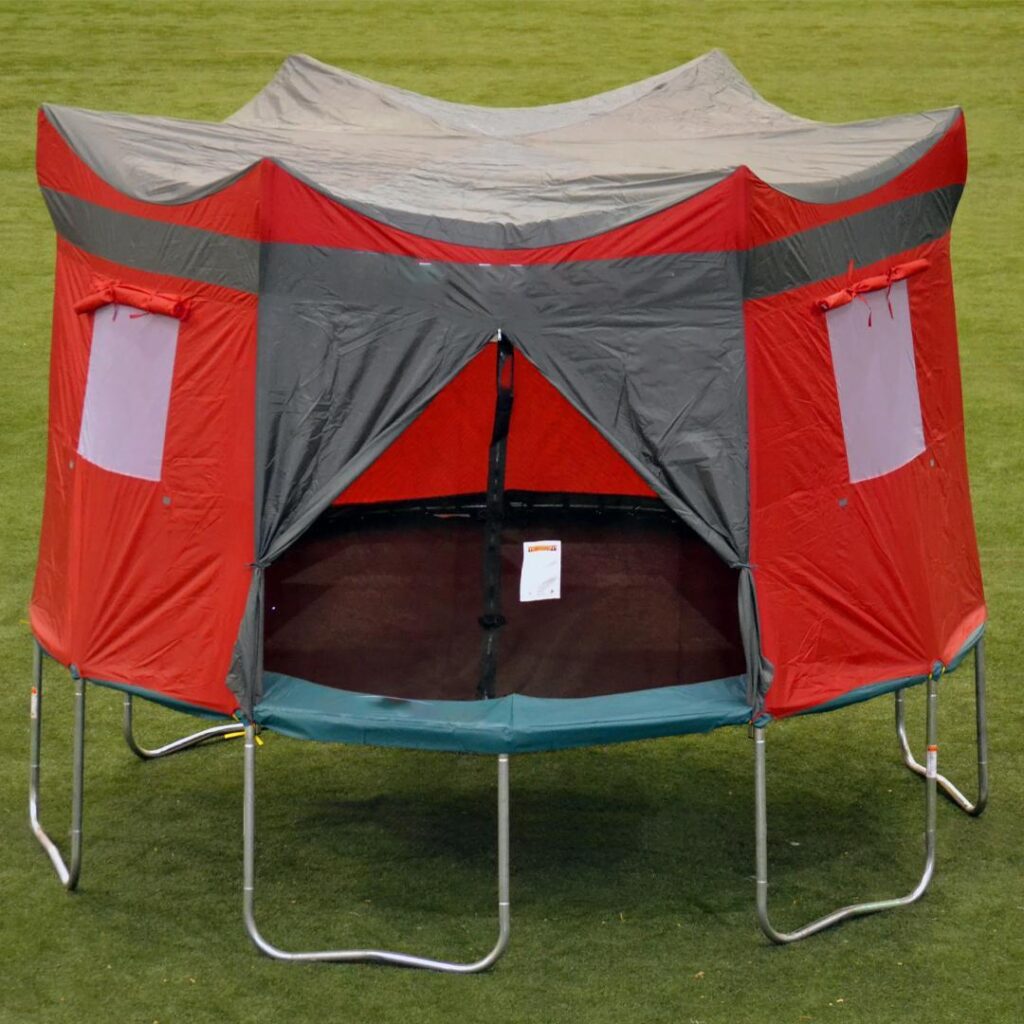Trampolines are already a fantastic way to keep children active and entertained, but there’s a common obstacle: unpredictable weather and wear and tear. From scorching heat to relentless rain, the elements can take a toll on your trampoline, reducing its lifespan and limiting playtime. Transforming your garden into a safe, year-round play zone has never been easier. But there’s a solution that combines protection with endless fun—the trampoline tent.

This innovative addition is more than just a cover; it’s a safeguard that extends the life of your trampoline while ensuring that playtime never has to pause.
Are you ready to improve the safety and durability of your trampoline? In this guide, we will help you select the ideal trampoline for your tent, offer simple assembly tips, and suggest ways to maximise the benefits of this upgrade. Stick with us, and by the end, you’ll know to create a safer, longer-lasting play area that your family can enjoy throughout the year. Let’s delve into trampoline tents and discover how they can enhance your trampoline experience!
Benefits of Trampoline Tent
Adding a tent to your family trampoline opens up a world of benefits that enhance both playtime and safety. Here’s a closer look at how this upgrade transforms your trampoline experience:
- All-Weather Fun: With a trampoline tent, weather becomes a non-issue. The tent protects users from extreme weather conditions such as intense heat, heavy rain, and gusty winds. As a result, your trampoline is ready for action regardless of the forecast, allowing for year-round enjoyment.
- Extended Playtime: By shielding the inground trampoline from the elements, the tent makes it usable throughout the year. This means that instead of storing your trampoline away during adverse weather, you can keep it in play and ready for fun, no matter the season.
- Perfect for Pyjama Parties: The trampoline tent creates a cosy, enclosed space ideal for imaginative play and sleepovers. Transform your trampoline into a pyjama party fun where children can enjoy a safe environment for lounging and playing late into the night.
- Trampoline Camping: Turn your garden into a mini campsite with the trampoline tent. children can experience the thrill of camping without leaving home, complete with a unique jumping adventure under the stars.
- Enhanced Safety: The tent provides an extra layer of security, reducing the risk of accidents. It keeps debris and animals away, while the enclosed space helps prevent falls and other injuries by creating a more controlled environment.
- UV Protection: The tent also shields your trampoline from harmful UV rays that can degrade the materials over time. You can also use PVC UV protection Spray to protect your trampoline UV rays. By blocking these rays, the tent helps prolong the life of your trampoline, keeping it in top condition and protecting your investment.
By now, you can see how a trampoline tent not only makes outdoor play more enjoyable but also safer and more versatile. Next, we’ll guide you through selecting the perfect trampoline for your new tent, ensuring you get the best fit for your garden fun.
How to Choose the Right Trampoline for a Tent
Choosing the perfect trampoline for your tent is crucial for ensuring a seamless and enjoyable outdoor experience. While it might seem daunting, finding the right match is straightforward once you know what to look for. Here are key factors to consider when selecting a trampoline for your tent:
- Size and Shape Considerations: Start by assessing the dimensions of both the trampoline and the tent. Make sure the trampoline’s size aligns with the tent’s design to ensure a proper fit. A trampoline that is too large or too small might not be compatible with the tent, affecting stability and safety. Pay attention to the shape as well—most tents are designed to fit round trampolines, but you can also find models suited for oval or rectangular trampolines.
- Material and Durability: Opt for a trampoline made from high-quality, weather-resistant materials. Look for frames constructed from galvanised steel to resist rust and corrosion. The jumping mat and springs should be made from durable, UV-resistant materials to withstand frequent use and exposure to the elements. A well-constructed trampoline will not only enhance safety but also extend the life of both the trampoline and the tent.
- Brand and Model Recommendations: Certain brands and models are known for their compatibility with trampoline tents. Brands like Skywalker, Springfree, Super Tramp Trampoline, and JumpSport offer trampolines that can be paired with various tent options. Research and read reviews to find models that have a proven track record for compatibility with tent accessories.
- Budget vs. Features: Make sure your needs and your budget are in balance. While higher-end trampolines might offer advanced safety features or additional accessories, they come at a premium. Consider what is essential for your family’s needs—such as durability, safety, and ease of setup—and weigh these factors against your budget to find the best value.
By keeping these considerations in mind, you’ll be well on your way to selecting a trampoline that not only fits your tent perfectly but also makes your experience memorable. Next, we’ll guide you through the assembly process, ensuring that you can set up your trampoline and tent combination with ease.
Assembly Instructions
Assembling a sport trampoline and tent might seem like a complex task, but with the right guidance, you can have it set up smoothly and efficiently. Follow these steps to ensure a successful installation and transform your trampoline into a versatile play space. Here’s how to get started:
Preparation Tips
- Choose a Flat, Level Surface: Ensure you set up the trampoline and tent on a flat, level area to provide stability and prevent wobbling.
- Clear the Area: Remove any debris, obstacles, or sharp objects from the setup area to avoid interference and potential damage.
- Gather Necessary Tools and Components: Collect all parts of the trampoline, the tent, stakes, and any tools needed for assembly, such as a wrench or screwdriver.
- Check Assembly Instructions: Review the assembly instructions for both the trampoline and tent to familiarise yourself with the process and ensure you have all the required parts.
- Prepare the Area: Ensure the setup space is large enough to accommodate both the trampoline and tent, allowing for easy movement during assembly.
Guide for you
- Unfold the Trampoline Tent: Begin by laying out the trampoline tent on a flat surface. Unfold it completely and locate the entrance of the tent. Align the entrance of the tent with the entrance of the trampoline to ensure a proper fit. This alignment is crucial for a seamless setup and prevents any awkward gaps.
- Attach the Tent to the Trampoline: Next, slowly pull the trampoline tent down along each enclosure pole of the trampoline. Make sure to smooth out any wrinkles or folds as you go to ensure a snug fit. The tent should fit neatly over the trampoline, with the poles sliding through their respective pockets or sleeves in the tent.
- Secure the Tent to the Trampoline Legs: Once the tent is positioned correctly, locate the straps or ties provided with the tent. These are used to secure the tent to the trampoline’s legs. Tie each strap around the legs of the trampoline, making sure they are tight but not overly strained. This helps anchor the tent in place and prevents it from shifting or flapping in the wind.
- Adjust the Ties as Needed: After securing the straps, check each one for proper tension. Adjust the ties if necessary to ensure that the tent is evenly distributed and firmly attached. This step helps maintain the tent’s shape and ensures that it remains securely fastened during use.
- Secure the Doors: Finally, close and secure the doors of the tent. Most tents come with zippers or Velcro closures to keep the doors shut. Make sure the closures are properly fastened to keep out insects and maintain the tent’s enclosed space. Double-check that there are no gaps where the tent and trampoline meet.
Common Pitfalls to Avoid to Fix Trampoline Tent
During assembly, be mindful of a few common pitfalls. Here are some common pitfalls:
- Ensure that the tent is not twisted or unevenly placed, as this can cause discomfort and instability.
- Avoid over tightening the straps, which can damage the tent or trampoline frame.
- If the tent appears loose or uneven, recheck the alignment and adjust the ties accordingly.
Maintenance Advice
To extend the life of your trampoline and tent, regular maintenance is key. Clean the tent periodically to remove dirt and debris, and inspect it for any signs of wear or damage. Keep the trampoline surface free from sharp objects that could puncture the mat. Store the tent in a dry place when not in use, and regularly check the trampoline’s springs and frame for any issues.
With these detailed instructions, you’re ready to enjoy a fully assembled trampoline and tent setup.
Conclusion
As we’ve explored, adding a tent to your trampoline opens up a world of possibilities for fun and safety. Give your family a gift that they cherish and love all year long.
Now it’s your turn to elevate your outdoor fun. Dive into selecting the perfect trampoline tent that suits your family’s needs and start creating unforgettable moments right in your garden.
We’d love to hear from you! Share your trampoline tent setup stories, creative ideas, or any questions you have in the comments section below. Your experiences could inspire others to take the leap and enhance garden fun. Let’s make every bounce count—join the conversation and share your trampoline tent journey!
Yes, you can put a cover on a trampoline to protect it from weather elements like rain and UV rays, extending its lifespan.
For a trampoline sleepover, you’ll need a tent or canopy, sleeping bags, pillows, blankets, and fairy lights or lanterns to create a cosy atmosphere.
Yes, you can camp on a trampoline by setting up a tent or sleeping bags on the mat, making it a fun and bouncy camping experience.
A 10 ft trampoline is generally safe for 1-2 kids at a time to avoid overcrowding and reduce the risk of injury.
You can hide your trampoline in your garden by placing it in a sunken area, surrounding it with shrubs or hedges, or using a trampoline cover that blends with your garden decor.





